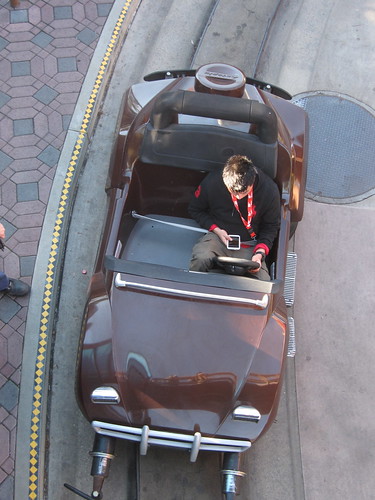I know I just wrote about the AAA study on cognitive load and distracted driving, but Liz Gannes on All Things D (which has a brilliant editor) has a piece on driving and distraction that illustrates our somewhat schizophrenic understanding of what distraction is, and how to deal with it, that’s too good to ignore.
Gannes writes:
When I drive my car, I have to command myself not to glance over at my phone. Was that email notification important? Should I let someone know that I’m running late? Has anybody posted anything cool to Instagram? Somehow, driving and listening to the radio seems like not enough to do anymore.
Obviously, I realize the dangers of distracted driving, and I know better. But I think that our tech tools could and should do a better job of helping us be safe.
I’ll grant that distracted driving– or multitasking while driving– is pervasive: I was struck during our last trip to Disneyland how many people were texting on Autopia.
Anyway, the article touches briefly on a couple tools that put your smartphone in airplane more or disable other functionalities when you’re in your car, but most of the time it assumes that tools that “do a better job of helping us be safe” need to take over the wheel, not help us be more focused when we drive.
More broadly, the article’s overarching narrative about technology, attention and driving runs like this:
- We’re going to have self-driving cars in a few years.
- Turning the phone off is too hard. Besides, nobody– not drivers, not passengers, and certainly not automotive telematics companies– wants to switch off.*
- Connection is inevitable.
- Therefore, we need interim solutions that help us multitask more safely.
So we hear about programs that read your email to you, that “provide voice versions of news articles” (what in the olden days we used to call “the radio”), or help you interact via voice with your phone (though the AAA study suggests that these are actually more distracting than holding a phone and making a call).
Of course, you’ll need these only until we automate the driving process enough to allow you to completely ignore the road and just get on with Facebook.
Okay.
While I understand the desire to ease the pain of driving, and make the roads safer for cyclists (my wife was hit by a truck a couple weeks ago while on her bike; we consider ourselves lucky that she only broke her elbow and wrist), I have to question the premises on three grounds.
First, isn’t it strange that when we are behind the wheel, we should treat driving as a distraction? Driving is a lot more dangerous and complicated an activity than we like to admit, and it really deserves our full attention; and driving well– learning to feel the road through the wheels, to anticipate and respond to problems, to become one with the machine– can be a real pleasure.
Using technologies to support “better” multitasking in the car on the grounds that most of us are already doing it is like Cosmopolitan arguing that because a quarter of people admit to answering their cellphones during sex, those people should wear Bluetooth headsets to bed. Or that we need smartphones equipped with sporks so we can more easily eat and text.
Second, automated driving systems are likely to make cars safer 99% of the time, but will also make for bigger, deadlier accidents. I’ve pointed to articles on the problems that pilots face when flying planes that are highly automated, and which largely fly on autopilot, and I don’t see any reason to think that the dynamic will be different on the road rather than the sky. As I explain in my book,
A 2011 report by the International Air Transport Association, issued in the wake of the 2009 crash of an Air France Airbus off the coast of Brazil, warned that airplanes were becoming so sophisticated that pilots didn’t have the chance to develop and maintain advanced flying skills. They’re trained to leave planes on autopilot for most of a flight, so they have fewer hours’ experience flying manually and therefore have a harder time handling emergencies, especially when the emergencies are caused by problems with the autopilot or instruments.
In other words, safety systems that work great when things are normal erode pilots’ capacity to deal with problems, which can turn dangerous but manageable situations into catastrophes (as seems to have happened with AF 447). Now, imagine this problem multiplied a millionfold, with people with far less training than commercial airline pilots, in environments with many many more obstacles, impediments, and things that can go wrong.
It’s bad enough that pilots struggle to understand what’s going on when their planes stall; if they were also distracted by live-tweeting, it would be really terrible.
Finally, the assumption that distraction is unavoidable, and that you can’t muster the will to put the phone away– even with the help of tools that automatically put your phone in airplane mode– is just wrong, wrong, wrong. Distraction is not inevitable, inescapable, and overwhelming: we can all learn, through a combination of discipline and defaults and practice, to refocus, to use our attention rather than have it be torn away from us (and these days, repacked and resold in the “attention economy”). At least, we have that ability until the self-driving car with built-in Foursquare and self-tweeting functionality comes on the market.
*Well, the NTSB, AAA, and anyone who’s lost a friend or loved one to a distracted driver might advocate switching off. But you know, whatever.
